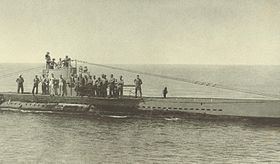Ordered 12 June 1912 Laid down 25 February 1913 Construction started 25 February 1913 Length 65 m Beam 6.3 m | Yard number 198 Commissioned 15 December 1914 Launched 9 September 1914 Draft 3.56 m | |
 | ||
Class and type German Type U 31 submarine Builder Friedrich Krupp Germaniawerft | ||
SM U-38 was a German Type U 31 U-boat which operated in the Mediterranean Sea during World War I. It ended up being the third most successful u-boat participating in the war sinking 138 ships sunk for a total of 299.985 tons.
Contents
Its longest serving captain was Kptlt. Max Valentiner, who was awarded the Pour le Mérite while in command of U-38. Valentiner was in command of U-38 in November and December 1915 when she sank the passenger liners Ancona and Persia; both were controversial since the ships were sunk by torpedoes without warning, in defiance of the then-current Prize rules, which stated that merchant vessels carrying passengers be given an opportunity to evacuate their passengers before being sunk.
In 1917 Valentiner was succeeded as commander of U-38 by Kptlt. Wilhelm Canaris, who decades later became an Admiral and head of the Abwehr (German Military Intelligence), in 1935-44.
Design
German Type U 31 submarines were double-hulled ocean-going submarines similar to Type 23 and Type 27 subs in dimensions and differed only slightly in propulsion and speed. They were considered very good high sea boats with average manoeuvrability and good surface steering.
U-38 had an overall length of 64.70 m (212 ft 3 in), her pressure hull was 52.36 m (171 ft 9 in) long. The boat's beam was 6.32 m (20 ft 9 in) (o/a), while the pressure hull measured 4.05 m (13 ft 3 in). Type 31s had a draught of 3.56 m (11 ft 8 in) with a total height of 7.68–8.04 m (25 ft 2 in–26 ft 5 in). The boats displaced a total of 971 tonnes (956 long tons); 685 t (674 long tons) when surfaced and 878 t (864 long tons) when submerged.
U-38 was fitted with two Germania 6-cylinder two-stroke diesel engines with a total of 1,850 metric horsepower (1,361 kW; 1,825 bhp) for use on the surface and two Siemens-Schuckert double-acting electric motors with a total of 1,200 PS (883 kW; 1,184 shp) for underwater use. These engines powered two shafts each with a 1.60 m (5.2 ft) propeller, which gave the boat a top surface speed of 16.4 knots (30.4 km/h; 18.9 mph), and 9.7 knots (18.0 km/h; 11.2 mph) when submerged. Cruising range was 8,790 nautical miles (16,280 km; 10,120 mi) at 8 knots (15 km/h; 9.2 mph) on the surface, and 80 nmi (150 km; 92 mi) at 5 knots (9.3 km/h; 5.8 mph) under water. Diving depth was 50 m (164 ft 1 in).
The U-boat was armed with four 50 cm (20 in) torpedo tubes, two fitted in the bow and two in the stern, and carried 6 torpedoes. Additionally U-38 was equipped in 1915 with one 8.8 cm (3.5 in) deck gun, which was replaced with a 10.5 cm (4.1 in) gun in 1916/17. The boat's complement was 4 officers and 31 enlisted.
Fate
After World War I ended, U-38 was surrendered to France and docked in Brest in 1919, and then broken up.
